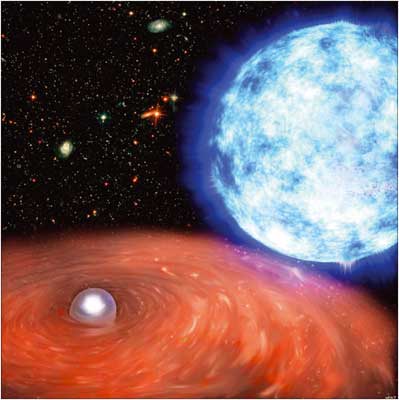
Image credit: Francesco Mereghetti, background image: NASA, ESA and T M Brown/STScI.
Using observations by ESA’s Newton X-ray multimirror satellite, XMM-Newton, a group of Italian astronomers has derived the characteristics of a peculiar binary system consisting of a white dwarf and an evolved companion star. The mass of the compact object is found to be close to the maximum mass for a white dwarf. Continued accretion in the million years to come could make it explode as a Type Ia supernova.
White dwarfs are the cores that remain of Sun-like stars after they have ejected their gas envelopes, creating beautiful planetary nebulae (CERN Courier July/August 2003 p13, April 2007 p10 and September 2009 p11). They are analogous to neutron stars, which are produced in the core-collapse (Type II) supernovae explosions of stars that are more than eight times as massive as the Sun. While neutron stars are only about 20 km across, white dwarfs are typically the size of the Earth and are sustained by the quantum-degeneracy pressure of their electrons, rather than their neutrons.
The shallower gravitational potential well of white dwarfs compared with neutron stars is not able to heat the gas accreted from a companion star up to very high temperatures. X-ray binaries, where the compact object is a white dwarf, are therefore much less luminous and only detectable in the soft X-ray waveband. The feeble X-ray emission from a binary system that was first detected by the ROSAT satellite in the 1990s was re-observed in 2008 by XMM-Newton. The observation of RX J0648.0-4418, which was proposed by a group of Italian astronomers led by Sandro Mereghetti from the INAF-IASF institute in Milan, was scheduled to catch a possible X-ray eclipse of the white dwarf as it passed behind the companion star. The aim was also to analyse the X-ray pulsation induced by the spin of the white dwarf with a period of 13.2 s.
The 12-hour observation by XMM-Newton was successful and provided a clear detection of the eclipse as well as allowing the possibility to derive relative time lags in the pulses from one hour to the next. These delays were used by the researchers to gauge the size of the orbit of the white dwarf around the companion star. With the corresponding information already available for the optical star through spectroscopic analysis, the only remaining unknown related to the mass of both objects is the orbital-plane inclination. However, this is well constrained by the observed eclipse of the X-ray source to be close to edge-on and the study yields values in units of solar masses of 1.28±0.05 for the white dwarf and 1.50±0.05 for the companion star.
For the compact object, this is about twice the usual mass of white dwarfs and is close to the limit of 1.4 solar masses that Subrahmanyan Chandrasekhar derived in the early 1930s. It means that the increased accretion expected in the million years to come could make the white dwarf reach this limit with two possible consequences: either the dwarf star explodes as a supernova of Type Ia or it collapses into a neutron star. Type Ia supernovae are bright events that are used as standard beacons to measure the expansion rate of the universe (CERN Courier September 2003 p23, October 2007 p13). If this is going to happen at the derived distance of only about 2800 light-years from Earth, the supernova would appear as bright as the full Moon for several days. However, the fast spin of the dwarf star is likely to increase its stability and should thus delay this celestial show or even prevent it from happening.







